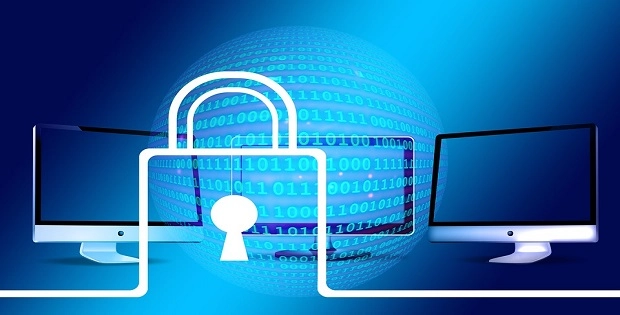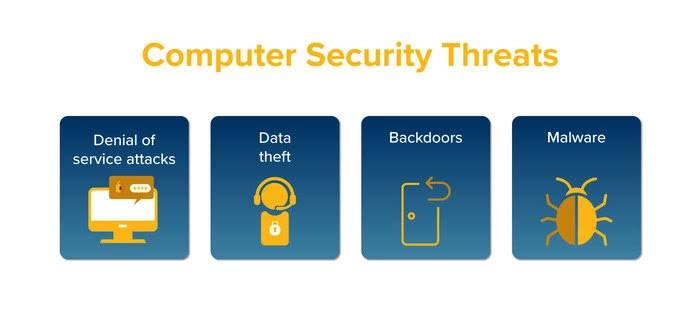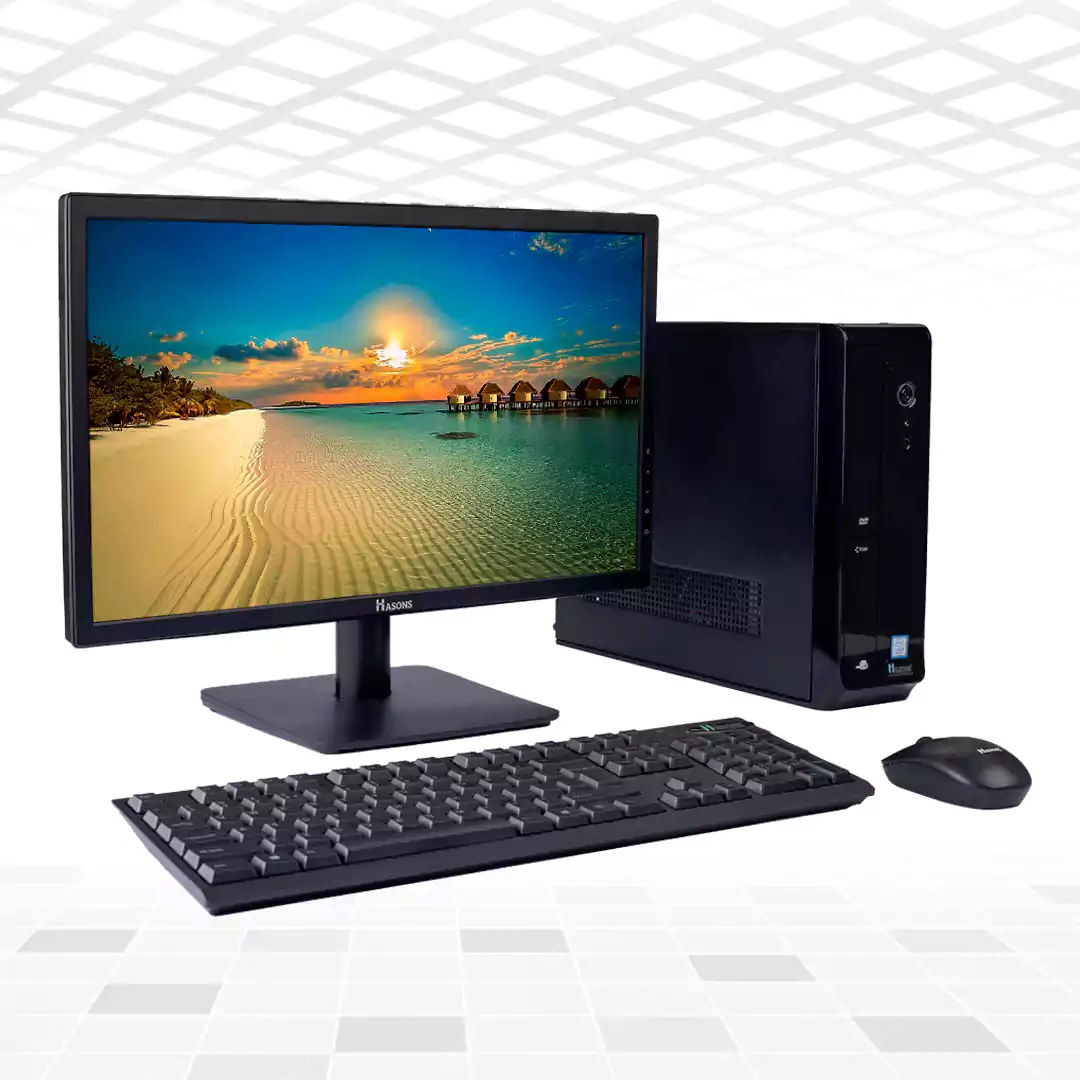Types of Computer Security
Computer security is crucial for protecting sensitive data and systems from cyber threats. As technology and cyber attacks become more advanced, organizations need layered defenses to secure networks, endpoints, applications, data, and infrastructure. There are several categories of computer Security to consider when developing a robust cybersecurity program. Understanding the main types of computer security can help organizations protect against evolving threats.

Network Security
Network security protects the system of hardware and software that enables Network communications. This involves securing local area networks (LANs), wide area networks (WANs), wireless networks, and other network communications systems. Some components of network security include:
- Firewalls – Hardware or software that monitors incoming and outgoing network traffic and blocks dangerous or unauthorized transmissions. Firewalls act as a barrier between internal and external networks.
- Intrusion detection and prevention systems (IDS/IPS) – Hardware or software that monitors networks for malicious activity or policy violations. IDS software detects intrusions and alerts security teams. IPS software goes a step further to actively block malicious traffic.
- Encryption – Encoding data with cryptography so only authorized parties can read it. This protects data confidentiality. Encryption protocols include SSL/TLS, SSH, IPSec, HTTPS, and WPA2.
- Virtual Private Networks (VPNs) – Extends a private network over public networks to enable remote access. VPNs encrypt connections to protect data in transit.
- Network segmentation – Divides networks into subnetworks to control access and contain breaches. Segmenting networks with VLANs and ACLs limits lateral movement.
Proper network security controls defend against threats like DDoS attacks, man-in-the-middle attacks, SQL injection, and more. Following cybersecurity best practices for network design, monitoring, access control, and vulnerability management is essential.
Endpoint Security
Endpoint security protects the network access points, or endpoints, that employees use to access corporate resources. Laptops, desktops, smartphones, and servers are common endpoints. Some elements of endpoint security include:
- Antivirus software – Detects and removes malware like viruses, worms, spyware, and ransomware from endpoints. Antivirus scans files, processes, and traffic.
- Endpoint detection and response (EDR) – Advanced threat detection and response technology that monitors endpoints for suspicious activity indicative of intrusions. EDR provides continuous monitoring and can automatically contain threats.
- Disk encryption – Encrypts endpoint hard drives to prevent unauthorized data access if a device is lost or stolen. Full disk encryption transforms data to unreadable cipher text.
- Host-based firewalls – Firewalls installed on endpoint devices to control inbound and outbound access at the host level. This provides an added layer of network access control.
- Patch management – Automated distribution of software updates and security patches to promptly address vulnerabilities on endpoints. This prevents exploitation of known weaknesses.
Effective endpoint security will integrate multiple protection capabilities to defend against malware, data breaches, unauthorized access, and insider threats.
Application Security
Application security focuses on securing software Applications that drive business processes. This involves protecting web apps, APIs, microservices, mobile apps, and other application code from vulnerabilities and threats. Elements include:
- Input validation – Checking and sanitizing untrusted input before processing to detect attacks like XSS, SQLi, and command injection. Validating expected syntax blocks exploits.
- Access control – Restricting access to application functions and data to only authorized users. Authentication, authorization, and session management mechanisms are used.
- Encryption – Protecting sensitive application data through cryptographic encoding to prevent unauthorized access. Encryption applies to data in transit and at rest.
- Code quality – Following secure coding best practices and performing static/dynamic analysis testing to identify vulnerabilities and confirm remediation. High code quality increases resilience.
Adopting DevSecOps processes and remediating OWASP Top 10 risks are key for baking security into the software development lifecycle. This results in more secure code.
QuantumPower I7812 Desktop
12th Generation 8GB RAM I7 Processor Desktop | H610 Motherboard 1 TB HDD |Keyboard And Mouse 21.5 Inch Screen
SHOP NOW
Data Security
Data security entails protecting all forms of data, whether at rest or in transit. This includes structured data like databases as well as unstructured data like documents. Tactics include:
- Access control – Permitting only authorized users and applications to access protected data through mechanisms like file permissions, authentication, and authorization. Zero trust access principles are ideal.
- Encryption – Encoding data with cryptography so only those with the decryption key can read it. Encryption protects data confidentiality and integrity.
- Tokenization – Substituting sensitive data with non-sensitive placeholders called tokens to reduce risk of exposure. Tokens have no exploitable value if stolen.
- Data loss prevention – Monitoring and controlling data to prevent breaches and leaks. DLP can block unauthorized upload/transfer attempts.
- Backups – Maintaining copies of critical data so it can be recovered in the event of disasters like ransomware or hardware failure. Air-gapped, immutable backups limit exposure.
Data-centric Security controls protect confidentiality, integrity, and availability of all data. Following data privacy regulations like GDPR demonstrates security due diligence.
Cloud Security
Cloud security addresses the unique risks associated with hosting infrastructure, platforms, and software in public cloud environments. Key focus areas include:
- Visibility – Gaining centralized visibility over cloud resources, configurations, activity, and threats since assets are hosted externally. Cloud access security brokers (CASBs) can enable visibility.
- Data protection – Applying robust encryption, tokenization, access controls, key management, and other controls discussed above to protect data in the cloud.
- Identity and access management – Managing identity and access to cloud services, especially enforcing principle of least privilege access through strong IAM policies.
- Secure configurations – Configuring cloud resources according to security best practice guidelines to enable features like encryption by default while disabling risks like public access.
- Vulnerability management – Scanning cloud resources for software vulnerabilities and misconfigurations then remediating issues promptly. Cloud workload protection platforms can automate scanning.
A shared responsibility model typically makes both the cloud provider and customer responsible for different aspects of cloud security that must be addressed collaboratively.
Physical Security
Physical security controls restrict physical access to sensitive IT infrastructure to protect against insider threats and hands-on attacks. Elements include:
- Perimeter security – Barriers like fences, gates, and manned guard booths protect the external borders of facilities. These deter unauthorized entry.
- Access control – Doors, locks, smart cards, biometric systems, and other access mechanisms control entry to areas like data centers and server rooms. Access is logged.
- Surveillance – Security cameras, CCTV monitors, and guards provide visibility into sensitive areas and can detect unauthorized activities.
- Environmental controls – Air conditioning, fire suppression, uninterruptable power supplies, and generators maintain optimal environmental conditions for critical systems.
- Protection against interference – Faraday cages block external radio signals that could interfere with network and computer equipment function. tempest protection similarly blocks electromagnetic interference.
Physical security works hand-in-hand with cybersecurity to create layered defenses against real-world, hands-on attacks that could bypass network perimeter security.
Social Engineering
Social engineering refers to manipulation and deception tactics used to trick employees into divulging confidential information or performing dangerous actions. Examples include:
- Phishing – Malicious emails pretending to be from trusted sources in order to infect systems with malware or steal login credentials and sensitive data. Spear phishing targets specific individuals.
- Vishing – Phishing attempts conducted over phone calls, often involving urgent pleas for personal information under false pretenses.
- Pretexting – Using lies and legends to impersonate staff from the help desk, vendors, or third parties to solicit unauthorized data.
- Baiting – Leaving infected storage devices or USB drives in common areas and waiting for victims to plug them into computers, unleashing malware.
- Quid pro quo – Offering a benefit or service like IT support in exchange for login credentials or access to systems.
- Tailgating – Following authorized employees into secure doors or areas without permission.
The most effective defense against social engineering is comprehensive security awareness training to educate employees. Technical controls like email filtering also help protect against phishing.
Mobile Security
Mobile security protects smartphones, tablets, laptops and other devices from threats associated with mobile Computing. Key aspects include:
- Device security – Enforcing password/PIN policies, remote wipe capabilities, encryption, and anti-malware to secure endpoint mobile devices against theft and attacks.
- App security – Vetting mobile apps for malware and vulnerabilities before approving them for enterprise app stores and employees’ personal devices. App reputation tools can assist.
- Network security – Using corporate VPNs, firewalls, and network access controls tuned for mobile to protect data in transit over cellular networks and WiFi. Network segmentation is critical.
- Data security – Securing sensitive data at rest on devices with encryption and access controls. Containerization can isolate corporate data.
With the workforce becoming increasingly mobile, securing these access points against evolving mobile threats is more important than ever.
Wireless Security
Wireless security focuses on securing WiFi networks and similar RF connections which transmit Network data over the air. Elements include:
- Encryption – Requiring robust WPA2/WPA3 encryption with strong passwords to encrypt wireless traffic, prevent eavesdropping, and block unauthorized access attempts.
- Network segmentation – Placing wireless networks into separate network zones using VLANs to limit access to wired resources if a wireless network is compromised.
- Access control – Leveraging 802.1X and RADIUS servers to enforce role-based authentication and authorization for WiFi network access. MAC address filtering can also permit list devices.
- Firewalling – Using wireless access points and controllers with integrated stateful packet inspection firewalls to monitor and filter wireless traffic for threats.
- Updating – Ensuring wireless infrastructure runs updated firmware with the latest security patches to prevent exploitation of vulnerabilities.
Proper wireless security principles secure WiFi networks against circumvention of wired network defenses via network bridging or eavesdropping.
Incident Response and Management
Security incident response and management involves planning and executing on processes for detecting, analyzing, containing, and recovering from cybersecurity incidents like data breaches, DoS attacks, or insider threats. Key aspects include:
- Preparation – Developing incident response plans/playbooks, training responders, acquiring tools, and taking baseline measurements to prepare for swift and effective incident handling.
- Detection and analysis – Using threat intelligence, anti-malware, EDR, SIEM, and other technologies to quickly detect and triage security incidents. Root cause analysis identifies remediation actions.
- Containment – Isolating compromised systems and accounts to limit an incident’s blast radius and prevent further damage. Tactics like disabling user accounts may be used.
- Eradication – Removing malware, disabling breached user accounts, patching vulnerabilities, or undertaking other actions to eliminate the root cause and remediate damages from incidents.
- Recovery – Restoring impacted systems to pre-incident configurations and hardening them to prevent repeat compromises. Returning to normal operations is the goal.
Effective incident response relies on preparation and continuous improvement to enable rapid containment and recovery when incidents inevitably occur.
Types of Computer Security Threats
In tandem with the computer security controls discussed above, organizations must understand and defend against various types of cyber threats that could impact networks and systems:

Viruses
- Malicious programs that self-replicate by infecting files, boot sectors, or other programs. Viruses like Melissa or spread rapidly and alter or destroy data.
- Antivirus software, system hardening, patch management, and user awareness training help prevent infection and limit damage from viruses.
Computer Worms
- Self-replicating, self-propagating malware that spreads itself automatically over networks, unlike viruses. Worms like Code Red and Slammer exploited vulnerabilities to spread globally.
- Promptly applying patches, disabling unnecessary services, and configuring firewalls properly prevents worm infections.
Phishing Attacks
- Fraudulent emails or sites that trick users into entering login credentials, bank details, or other sensitive information, enabling cyber theft and fraud. Spear phishing targets specific individuals.
- Security awareness training combined with email security solutions like filtering helps protect against phishing and social engineering.
Botnets
- Networks of hijacked computers controlled remotely by cybercriminals to launch attacks. Botnets like Trick Bot and Emotet enable fraud, ransomware, and more.
- Anti-malware, system hardening, credential protection, and regular vulnerability management disrupt botnet infections.
Rootkits
- Malware that masks its presence and activity on infected systems by subverting Operating Systems at the kernel level to avoid detection.
- Hardware verification, malware scanning, and monitoring system state can detect sophisticated rootkits. Reimaging compromised systems is recommended.
Keyloggers
- Malware that covertly tracks keystrokes on compromised systems to steal credentials, financial details, and other sensitive data as users type them.
- Anti-keylogging defenses include biometric multifactor authentication rather than passwords alone, securing endpoints, monitoring credential use, and verifying software integrity.
Significance of Computer Security
Robust cybersecurity is critically important given the frequency and sophistication of modern cyber threats. Effective computer security offers organizations many benefits:
- Protects confidential business data and intellectual property from theft or unauthorized access
- Prevents fraud, financial theft, and monetary losses resulting from data breaches
- Maintains availability of critical IT systems and prevents disruptive outages from cyber attacks
- Safeguards consumer and employee privacy and fulfills compliance obligations
- Preserves trust and reputation by demonstrating security due diligence to customers
- Limits costs, legal liabilities, and recovery burdens from security incidents
- Enables innovation and digital transformation built on principles of zero trust and secure architecture
By assessing risks and making prudent investments in layered controls, organizations can implement pragmatic cybersecurity programs that balance protection, productivity, and cost. Ongoing security improvements also build long term resilience.
Best Practices for Computer Security
Some best practices that organizations should follow to strengthen computer security include:
- Perform ongoing risk assessments to identify and prioritize key assets, data, and systems to safeguard. Align security controls with business risk.
- Implement defense-in-depth with preventive, detective, and responsive controls at multiple layers like network, endpoint, application, and data levels.
- Secure infrastructure through practices like system hardening, regularly patching systems, password policies, and disabling unneeded services and ports.
- Develop and exercise incident response plans to ensure effective preparation for rapid detection, containment, eradication, and recovery when incidents do occur.
- Provide comprehensive security training to promote employee awareness and engagement regarding policies, threat recognition, reporting, social engineering red flags, and other aspects of human-focused cybersecurity.
Diligent, ongoing implementation of these fundamental practices will enhance cybersecurity posture over time.
Conclusion
Effective cybersecurity requires implementing and actively managing a layered blend of people, process, and technology controls that align with organizational objectives and risk tolerance. Network Security, endpoint protection, cloud security, identity management, and other domains discussed in this post all build collective defenses. Understanding different categories of computer security threats also informs prudent strategies to harden infrastructure and applications against common attacks. With cyber risks continuously evolving, organizations must take a nimble, risk-based approach to strengthen security over time through continuous enhancements. The right combination of prevention, detection, and response mechanisms tailored to address identified risks will empower organizations to thrive in the digital world.
| For updates in the Types of Computer Security , read Hasons Blogs. Some of them are as follows: | ||
| Virtual Machine | Tree Topology in Computer Networks | |

